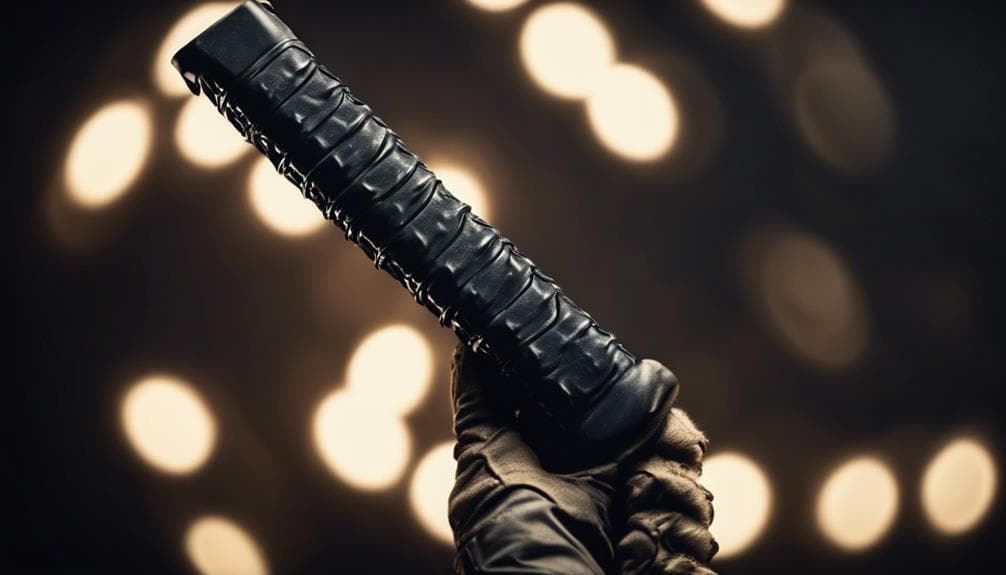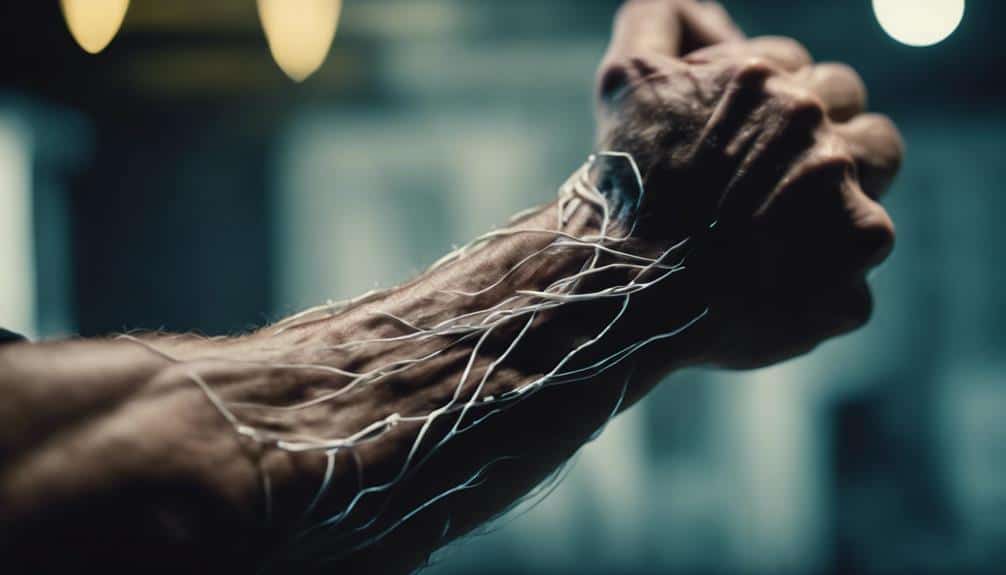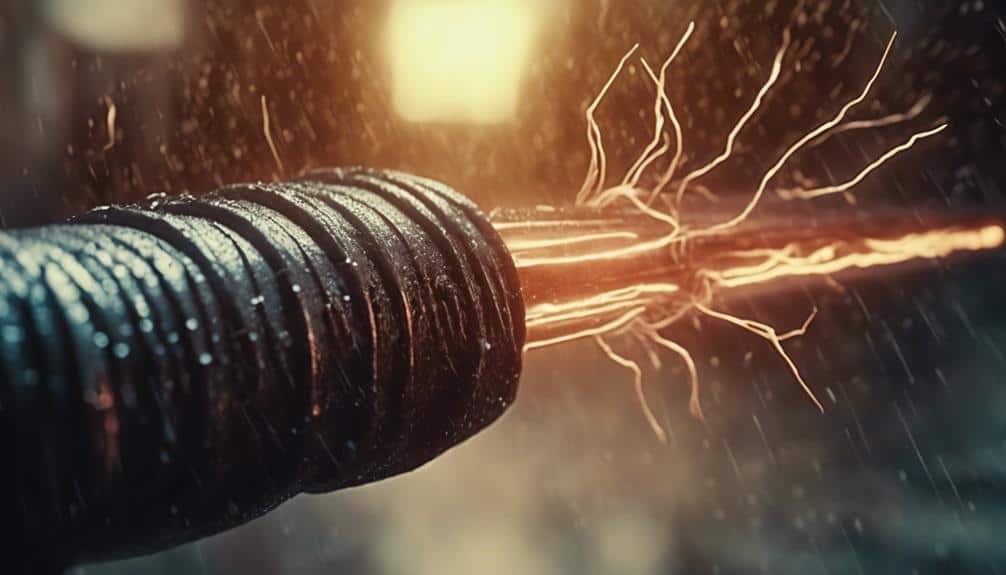How Painful Is a Stun Baton?
Getting hit with a stun baton feels like a sudden, high-voltage zap that disrupts your nerves and sends you into uncontrollable muscle spasms. It’s like touching a live wire, but magnified, leading to sharp, searing pain that makes you involuntarily lose control and balance. The pain can linger, with some people feeling sore for minutes to hours afterward. Factors like the shock’s duration, your body mass, and even what you’re wearing can alter the pain’s intensity. It’s potent yet designed not to cause lasting harm, ensuring you’re temporarily down but not out. Curious about how these devices compare and the nitty-gritty details?
 Stun batons are powerful self-defense tools that deliver high-voltage shocks to incapacitate threats. Imagine you’re faced with a sudden danger; these devices emit an electrical shock that causes intense pain and involuntary muscle contractions, rendering your attacker temporarily incapacitated. It’s like having a lightning bolt in your hand, ready to zap troublemakers into submission.
When you use a stun baton, you need to make physical contact with the target, ensuring the electrical current flows directly into them. The result? An immediate, painful reaction that disrupts their nervous system and muscles, making it hard for them to move or continue their assault. It’s not just about the pain; it’s about the complete disorientation and loss of motor control that follows.
Stun batons are designed for close-range use, which means you need to be within arm’s reach of the threat. While this might sound a bit intimidating, the assurance of having a reliable self-defense tool can be incredibly empowering.
Legal regulations, though, can vary widely depending on where you live, often requiring permits or age restrictions. So, check your local laws before zapping your way to safety!
Stun batons are powerful self-defense tools that deliver high-voltage shocks to incapacitate threats. Imagine you’re faced with a sudden danger; these devices emit an electrical shock that causes intense pain and involuntary muscle contractions, rendering your attacker temporarily incapacitated. It’s like having a lightning bolt in your hand, ready to zap troublemakers into submission.
When you use a stun baton, you need to make physical contact with the target, ensuring the electrical current flows directly into them. The result? An immediate, painful reaction that disrupts their nervous system and muscles, making it hard for them to move or continue their assault. It’s not just about the pain; it’s about the complete disorientation and loss of motor control that follows.
Stun batons are designed for close-range use, which means you need to be within arm’s reach of the threat. While this might sound a bit intimidating, the assurance of having a reliable self-defense tool can be incredibly empowering.
Legal regulations, though, can vary widely depending on where you live, often requiring permits or age restrictions. So, check your local laws before zapping your way to safety!
The pain you feel depends on factors like your pain threshold and the duration of the stun gun shock. For instance, thicker clothing may reduce the electric current’s impact, while a longer duration of contact can intensify the pain. Understanding the mechanism of pain helps explain why these electrical shocks can be so debilitating.
 When a stun baton makes contact, you’ll experience sharp, sudden pain paired with intense muscle contractions that feel like a cramp on steroids, leaving you momentarily incapacitated.
Imagine accidentally touching an electric fence, but intensified and targeting your muscles directly.
The shock can cause you to lose balance, feel disoriented, and struggle to breathe, making it hard to do anything but focus on the overwhelming discomfort.
When a stun baton makes contact, you’ll experience sharp, sudden pain paired with intense muscle contractions that feel like a cramp on steroids, leaving you momentarily incapacitated.
Imagine accidentally touching an electric fence, but intensified and targeting your muscles directly.
The shock can cause you to lose balance, feel disoriented, and struggle to breathe, making it hard to do anything but focus on the overwhelming discomfort.
 Understanding the factors that influence the pain from a stun baton can help you better grasp why the experience varies so widely.
The pain you feel primarily depends on the voltage and duration of the electrical shock. Higher voltage and longer shocks naturally ramp up the discomfort. Stun batons measure their zaps in microcoulombs. For a bit of reference, effective self-defense models crank out at least 1.0 microcoulombs, while the National Institute of Justice pegs the pain threshold at around 0.5 microcoulombs.
Your personal pain tolerance also plays a huge role. Some people might feel like they’ve been hit by lightning, while others may only experience a sharp sting. The contact site is essential too—jabbing the torso or sensitive areas like the neck or face can lead to intense pain and muscle spasms.
Here’s a quick rundown to evoke some empathy:
Understanding the factors that influence the pain from a stun baton can help you better grasp why the experience varies so widely.
The pain you feel primarily depends on the voltage and duration of the electrical shock. Higher voltage and longer shocks naturally ramp up the discomfort. Stun batons measure their zaps in microcoulombs. For a bit of reference, effective self-defense models crank out at least 1.0 microcoulombs, while the National Institute of Justice pegs the pain threshold at around 0.5 microcoulombs.
Your personal pain tolerance also plays a huge role. Some people might feel like they’ve been hit by lightning, while others may only experience a sharp sting. The contact site is essential too—jabbing the torso or sensitive areas like the neck or face can lead to intense pain and muscle spasms.
Here’s a quick rundown to evoke some empathy:
 Just as the psychological impact can linger, the physical pain of a stun baton often feels more intense compared to other devices like stun guns, TASERs, or pepper spray. The larger surface area of contact with a stun baton means it can deliver more extensive electrical shocks, resulting in severe muscle contractions that can incapacitate you almost instantly. Imagine the discomfort you’d feel from a traditional stun gun, then amplify that sensation to understand the agonizing grip of a stun baton.
Consider these comparisons to evoke a visceral reaction:
Just as the psychological impact can linger, the physical pain of a stun baton often feels more intense compared to other devices like stun guns, TASERs, or pepper spray. The larger surface area of contact with a stun baton means it can deliver more extensive electrical shocks, resulting in severe muscle contractions that can incapacitate you almost instantly. Imagine the discomfort you’d feel from a traditional stun gun, then amplify that sensation to understand the agonizing grip of a stun baton.
Consider these comparisons to evoke a visceral reaction:
The pain from a stun baton can be intense, causing muscle spasms and even a loss of balance. But with responsible usage, you can reduce these effects. Always keep the baton away from vulnerable areas to lower the chances of causing serious injury. Additionally, be mindful of the psychological trauma that can result from the shock, and use the device only when absolutely necessary.
 Understanding the legal implications of using a stun baton is essential to guarantee you’re compliant with local laws and avoid potential criminal charges. Legal regulations vary greatly, so before carrying or using one, you need to be crystal clear on your local laws. Misuse can lead to serious consequences, including criminal charges like assault or battery. Compliance isn’t just about knowing the rules; it’s about protecting yourself legally.
Consider these important points:
Understanding the legal implications of using a stun baton is essential to guarantee you’re compliant with local laws and avoid potential criminal charges. Legal regulations vary greatly, so before carrying or using one, you need to be crystal clear on your local laws. Misuse can lead to serious consequences, including criminal charges like assault or battery. Compliance isn’t just about knowing the rules; it’s about protecting yourself legally.
Consider these important points:
Overview of Stun Batons

Mechanism of Pain
When a stun baton makes contact with the skin, it delivers a high-voltage shock that disrupts the body’s electrical signals, causing intense pain and immediate muscle contractions. This shock, known as a stun gun shock, sends an electric current through your body that interferes with the normal functioning of your nerve cells. Imagine your muscles suddenly getting mixed messages, leading to involuntary spasms and, yes, some very intense pain. The mechanism of pain from a stun baton’s electrical shocks can be broken down into a few key components:| Component | Description |
|---|---|
| Electrical Current | High-voltage, low-current shocks that affect nerve cells. |
| Muscle Spasms | Involuntary contractions caused by disrupted electrical signals. |
| Pain Intensity | Varies based on individual pain tolerance and sensitivity. |
| Contact Duration | Longer contact increases pain and muscle disruption. |
| External Factors | Clothing thickness and body mass can influence pain perception. |
Immediate Physical Effects

Intense Muscle Contractions
Upon contact, a stun baton delivers a high-voltage shock that causes your muscles to contract intensely, resulting in immediate, sharp pain. The electrical shocks from a stun baton disrupt your nerve signals, leading to involuntary muscle contractions that override your body’s natural control mechanisms. This intense muscle activity can feel like your muscles are being twisted or squeezed, producing an overwhelming discomfort that varies based on your pain tolerance and body mass. These muscle contractions don’t just cause pain; they also lead to a significant loss of control. You may find it difficult to maintain balance, increasing the risk of a sudden fall. The immediate physical effects are compounded by the fact that your muscles are working overtime, leading to rapid fatigue and exhaustion. It’s like doing an intense workout in mere seconds, leaving you breathless and dizzy. People often underestimate how disorienting these electrical shocks can be. Picture trying to stand on a moving ship while someone is shaking you; that’s the level of instability you might experience. The combination of sharp pain, muscle spasms, and loss of control makes the stun baton a formidable tool for self-defense or law enforcement, ensuring immediate compliance from anyone on the receiving end.Sharp, Sudden Pain
A stun baton delivers a sharp, searing pain that immediately disrupts your ability to control your muscles. When the high-voltage electrical current courses through your body, it feels like a thousand tiny needles stabbing you all at once, triggering involuntary muscle contractions that leave you momentarily helpless. This sharp pain isn’t just a minor inconvenience; it’s like a full-body wake-up call you didn’t ask for. Imagine accidentally touching an electric fence, but magnified and relentless. The stun gun’s electrical current causes such intense muscle contractions that you could experience temporary paralysis, making it hard to stand, let alone escape. Disorientation sets in almost instantly, leaving you feeling like you’ve been spun around in a dizzying carnival ride, but without the fun part. Different people react differently to this high-voltage shock; while some might feel excruciating pain, others might find it somewhat bearable. The pain can last several minutes, during which you might struggle to regain your bearings. It’s like having your body’s control panel hijacked, leading to moments of sheer, disorienting agony.Duration of Pain
The pain from a stun baton can last anywhere from several minutes to hours, influenced by factors like voltage, contact duration, and an individual’s pain tolerance. When you first get zapped, the pain is usually intense and sharp, akin to a searing sensation that jolts you to attention. This acute pain can feel like eternity packed into a few seconds, but don’t worry, it generally diminishes fairly quickly. After the initial shock, the discomfort can linger, varying in duration. For some, recovery might involve just a few minutes of soreness, while others could experience lingering discomfort that stretches into hours. The effective contact time for a stun baton is typically between 3 to 5 seconds; any longer, and you might find yourself dealing with increased pain and prolonged soreness. Imagine touching a hot stove—brief contact results in a sharp pain, but it’s over quickly, allowing you to recover without lasting damage. Similarly, while a stun baton’s acute pain is designed to incapacitate, it usually doesn’t leave behind lasting harm, just a bit of soreness and a newfound appreciation for pain-free moments.Factors Influencing Pain

- Voltage and Duration: Higher voltage and longer shocks equal more pain.
- Microcoulombs: Effective models deliver 1.0 microcoulombs, exceeding the 0.5 microcoulomb pain threshold.
- Pain Tolerance: Varies widely from person to person.
- Contact Site: Torso and sensitive areas amplify pain and risk.
Psychological Impact
Exposure to a stun baton can trigger immediate psychological reactions like fear, confusion, and helplessness. You might find yourself grappling with the intense pain and disorientation, leaving you bewildered and vulnerable. It’s like suddenly being thrust into a horror movie where you’re the unsuspecting victim. These emotional responses can be overwhelming, leading to long-term issues like anxiety, depression, and even PTSD. Imagine trying to recall what happened during the incident, only to find your memory playing tricks on you with flashbacks and dissociative symptoms. This not only impacts your mental well-being but also chips away at your self-esteem. Feelings of vulnerability can linger, making you question your safety and control over your environment. The psychological impact doesn’t just fade away; it demands attention. Trauma-informed care is essential in these situations. Immediate psychological support can be the difference between a manageable recovery and a prolonged struggle with mental health. Think of it as a mental first-aid kit, vital for mitigating the emotional fallout.Comparisons to Other Devices

- Stun Batons: High-voltage shocks cause overwhelming pain and muscle contractions.
- TASERs: Comparable pain levels, but with prongs that can penetrate the skin.
- Stun Guns: Intense but localized shocks, less surface area covered.
- Pepper Spray: Causes burning and irritation, but doesn’t incapacitate through electrical means.
Safety Considerations
When using a stun baton, prioritize safety to minimize the risk of causing serious harm. You need to recognize the risks associated with stun batons, including potential physical injuries and psychological trauma. Responsible usage is essential to guarantee you don’t inflict unnecessary pain or cause serious injury. For instance, avoid aiming at sensitive areas like the chest, which can escalate the risk of severe harm. Here’s a quick guide to help you navigate safety considerations:| Risk | Safety Measures | Outcome |
|---|---|---|
| Pain | Aim for limbs or large muscle groups | Less intense pain |
| Serious Injury | Avoid head and chest areas | Reduced injury risk |
| Psychological Trauma | Use only in self-defense situations | Minimized trauma |
Legal Implications

- State Restrictions: Some states require permits or completely ban stun batons. Ignorance isn’t an excuse!
- Self-Defense Laws: Know when and how you can legally use a stun baton for self-defense. Overstepping can land you in hot water.
- Excessive Force: Using a stun baton excessively can lead to severe legal consequences. It’s not just about defending yourself but doing it within legal bounds.
- Civil Liability: Misusing a stun baton can lead to civil lawsuits. Imagine trying to explain to a judge why you thought zapping someone for fun was a good idea!
Choosing the Right Stun Baton
When choosing the right stun baton, you’ll want to balance durability and reliability with power and voltage, ensuring your device doesn’t just look tough but also packs a punch when it counts. Portability and design are essential too—think about how easy it is to carry and handle, especially in stressful situations where every second matters. Picture yourself in an emergency: a lightweight, ergonomic baton with a solid voltage can make all the difference, like having a superhero tool ready at your fingertips!Durability and Reliability
To choose the right stun baton, focus on models that excel in both durability and reliability. When it comes to self-defense, you don’t want to compromise on these vital features. Durability guarantees your baton can handle physical impacts and resist environmental wear and tear, while reliability means it will perform consistently when you need it most. High-quality materials like aircraft-grade aluminum contribute to both these factors, providing a robust and long-lasting tool. Consider the following when evaluating stun batons:- Safety Mechanisms: Look for built-in features that prevent accidental discharge, because the last thing you need is an unintended shock.
- LED Flashlights: Integrated lights can be a lifesaver, literally. They enhance visibility in dark situations, adding an extra layer of effectiveness.
- Product Testing: Opt for models that have undergone rigorous testing. This guarantees they’ll perform reliably, especially in high-stress scenarios.
- Grip Design: A comfortable, ergonomic handle can make all the difference. You want a baton that’s easy to wield, so you can focus on your safety.
Power and Voltage
Choosing the right stun baton means considering its power and voltage to guarantee it meets your self-defense needs effectively. When you’re picking a stun baton, you need to look at its voltage; these batons typically range from 50,000 to a whopping 1,000,000 volts. High voltage means intense electrical shocks that cause serious pain and muscle spasms, making it a formidable tool against an assailant. But voltage isn’t the only thing that matters. The real measure of a stun baton’s effectiveness is in microcoulombs. Anything above 1.0 microcoulombs is recommended for significant pain induction, ensuring the baton is effective in stopping a threat. Imagine it like this: voltage is the speed of a punch, while microcoulombs measure the punch’s strength. You want a balance of both for maximum impact.Portability and Design
Selecting a stun baton for self-defense means considering its portability and design to guarantee it’s both effective and easy to carry. You want something that’s lightweight yet powerful, making sure you can handle it with ease in any situation. Many stun batons are crafted from lightweight materials, making them simple to transport without feeling like you’re lugging around a brick. When choosing the right stun baton, pay attention to these key features:- Portability: Look for compact dimensions that won’t weigh you down.
- User Comfort: Ergonomic grips and adjustable straps can make all the difference in a high-pressure moment.
- Safety Switch: This vital feature prevents accidental discharge, adding an extra layer of safety.
- LED Flashlight: Ideal for low-light conditions, enhancing your visibility and practical use.
Frequently Asked Questions
How Strong Is a Stun Baton?
A stun baton’s voltage is high enough to cause intense muscle contractions. Its effectiveness depends on the design and proper usage. Ascertain you understand its safety, legality, and maintenance to maximize its incapacitating effects while minimizing risks.Are Stun Batons Lethal?
Stun baton safety is essential because, while not typically lethal, improper use can lead to serious injury risks. Considering legal implications, guarantee user training on electrical effects and explore alternative self-defense tools to mitigate potential harm.Can a Stun Baton Knock You Out?
A stun baton won’t usually knock you out. Its electrical shock primarily causes temporary paralysis and disorientation. As a self-defense tool, its incapacitation potential depends on pain tolerance, focusing on personal safety rather than unconsciousness.What Hurts More a Taser or a Stun Gun?
When comparing taser effects with a stun gun, a taser generally hurts more. The electrical shock targets multiple muscle groups, causing intense pain. For self-defense tools, consider safety concerns and usage scenarios when choosing between them.
Facebook
Twitter
LinkedIn
Pinterest


One Response